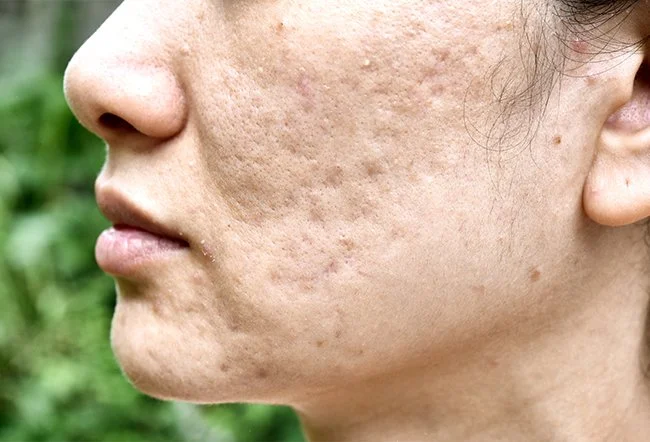Acne can become a long-term (chronic) condition. Even if it occurs only during adolescence, it may sometimes leave lifetime scars. Acne scars can become sunken (depressed) due to tissue loss, which can look like ice pick pits. In addition, they might be rolling, giving a wavy pattern on the skin, or boxlike. These are commonly found on the face and are referred to as boxcar acne scars. Acne scars can also be elevated due to extra tissue in the form of a keloid or hypertrophic scar. These are more frequent on the back and chest. Finally, acne can leave colourful marks. In lighter skin, these blotches might appear purple, red, or pink. In darker skin, they might be tan to dark brown. These are not scars and will usually disappear over time.
Acne scar treatment
Your healthcare practitioner will recommend particular techniques to reduce acne scars based on the following:
- Age, general health, and medical history
- Scar severity
- Scar type
- Your preference for specific medications, treatments, or therapies
Acne therapy can help reduce scarring. However, some procedures may help to reduce acne scars even more. Below are several techniques to remove acne scars.
Dermabrasion
This procedure can reduce tiny scars, minor skin surface imperfections, surgical scars, and acne scars. It entails scraping (abrading) the top layers of skin with a piece of electrical equipment. The surface will appear smoother and more youthful as the skin recovers after surgery. You will generally need 5 to 7 days at home to heal. Microdermabrasion is among the less intrusive procedure. The overall process consists of multiple treatments that do not need the same amount of downtime.
Chemical peels
Chemical peels frequently treat sun-damaged skin, uneven colour (pigmentation), and superficial scars. The skin’s top layer is removed using a chemical that is administered to the skin. The skin regenerates by eliminating the top layer. This method will result in an improved look.
Dermal filler injections
These are injected beneath the skin to replenish the body’s natural collagen that has been lost. Injectable dermal fillers repair wrinkles, depressed acne scars, and facial lines. However, most fillers are only temporary. They often endure 6 to 18 months.
Laser resurfacing and light treatments
Laser resurfacing employs high-energy light to burn away damaged skin. For instance, procedures such as the pico laser treatment can reduce skin imperfections, including acne scarring. To cure elevated acne scars, a pulsed dye laser may be employed. Intense pulsed light may be an alternative for persons with lighter skin.
Punch grafts
Punch grafts are microscopic skin transplants used to restore damaged skin. First, a hole is made in the skin to eliminate the scar. This is then restored with scar-free skin (often from the back of the earlobe). In this way, punch grafts can aid in healing deep acne scars.
Subcutaneous incision
A surgical probe is used to remove the skin from the scar tissue, which will cause the skin to rise. It will eventually smooth the surface of depressed acne scars.
Autologous fat transfer
This procedure injects fat from another part of your body into your skin. The practitioner will insert fat beneath the skin’s surface to elevate depressed scars. This procedure addresses deep contour flaws produced by scarring from nodulocystic acne. Over time, the fat may be reabsorbed into the skin. As a result, the operation may have to be repeated.
Injections
These are commonly referred to as intralesional injections. These include injecting a medication, generally a steroid, directly into a raised scar. This process causes the scar to flatten and soften. Because of this, multiple treatments are frequently required.
Cryotherapy
This procedure causes the scar tissue to die by freezing it, which will fall off. This method sometimes uses intralesional injections. One possible side effect of cryotherapy is skin whitening. This makes the treated region lighter than the surrounding skin.
Topical creams
Scar creams containing retinoids or silicone can also assist in reducing acne scarring.



